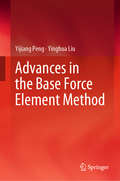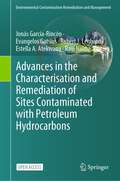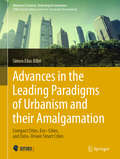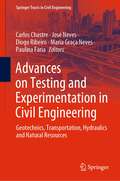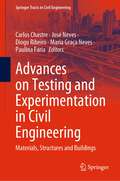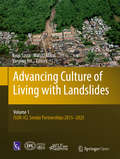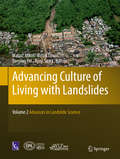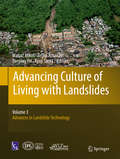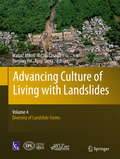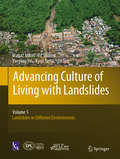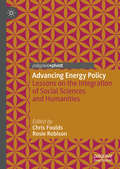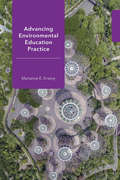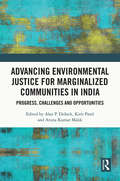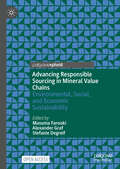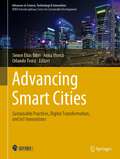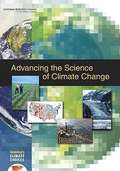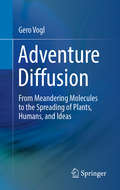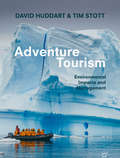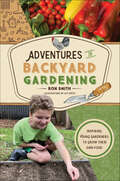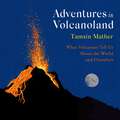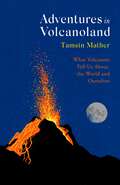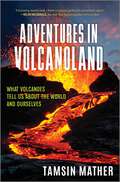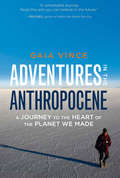- Table View
- List View
Advances in the Base Force Element Method
by Yijiang Peng Yinghua LiuThis book describes the main concepts of and recent advances in the base forces element method (BFEM). It combines theories, methods, models, numerical results, and an analysis of the BFEM. Each chapter starts with an introduction and derivation of a new mathematical model for the proposed method. Subsequently, the methods are described and numerical examples demonstrating the significance of the proposed method are presented. The closing chapter summarizes the performance and features of the BFEM and describes the prospects for its application. The book is intended for engineers, scientists and graduate students in applied mechanics and applied mathematics, and for all readers interested in numerical computations and simulations.
Advances in the Characterisation and Remediation of Sites Contaminated with Petroleum Hydrocarbons (Environmental Contamination Remediation and Management)
by Ravi Naidu Jonás García-Rincón Evangelos Gatsios Robert J. Lenhard Estella A. AtekwanaThis open access book synthesizes important advances in the assessment and management of soil and groundwater systems contaminated with petroleum hydrocarbons, especially in the form of light non-aqueous phase liquids (LNAPLs). LNAPL characterization and remediation is challenging due to the multi-phase, multi-component nature of the problem and the various physical, chemical, and biological processes involved in a dynamic and heterogeneous hydrogeological setting. This book focuses on the current state of practice of LNAPL characterization and remediation and seeks to provide information and a framework that would allow some of these complexities to be better addressed by contaminated land practitioners, researchers, and regulators.
Advances in the Leading Paradigms of Urbanism and their Amalgamation: Compact Cities, Eco–Cities, and Data–Driven Smart Cities (Advances in Science, Technology & Innovation)
by Simon Elias BibriThis book explores the recent advances in the leading paradigms of urbanism, namely compact cities, eco-cities, and data–driven smart cities, and the evolving approach to their amalgamation under the umbrella term of smart sustainable cities. It addresses these advances by investigating how and to what extent the strategies of compact cities and eco-cities and their merger have been enhanced and strengthened through new planning and development practices, and are being supported and leveraged by the applied solutions pertaining to data-driven smart cities. The ultimate goal is to advance sustainability and harness its synergistic effects on multiple scales. This entails developing and implementing more effective approaches to the balanced integration of the three dimensions of sustainability, as well as to producing combined effects of the strategies and solutions of the prevailing approaches to urbanism that are greater than the sum of their separate effects in terms of the tripartite value of sustainability. Sustainable urban development is today seen as one of the keys towards unlocking the quest for a sustainable world. And the big data revolution is set to erupt in cities throughout the world, heralding an era where instrumentation, datafication, and computation are increasingly pervading the very fabric of cities and the spaces we live in thanks to the IoT. Big data and the IoT technologies are seen as powerful forces that have tremendous potential for advancing urban sustainability. Indeed, they are instigating a massive change in the way sustainable cities can tackle the kind of special conundrums, wicked problems, and significant challenges they inherently embody as complex systems. They offer a multitudinous array of innovative solutions and sophisticated approaches informed by groundbreaking research and data–driven science. As such, they are becoming essential to the functioning of sustainable cities. Besides, yet knowing to what extent we are making progress towards sustainable cities is problematic, adding to the fragmented, conflicting picture that arises of change on the ground in the face of the escalating rate and scale of urbanization and in the light of emerging ICT and its novel applications. In a nutshell, new circumstances require new responses. This timely and multifaceted book is intended for a wide readership. As such, it will appeal to researchers, academics, urban scientists, urbanists, planners, designers, policy-makers, and futurists, as well as all readers interested in sustainable cities and their ongoing and future data-driven transformation.
Advances on Testing and Experimentation in Civil Engineering: Geotechnics, Transportation, Hydraulics and Natural Resources (Springer Tracts in Civil Engineering)
by José Neves Diogo Ribeiro Carlos Chastre Maria Graça Neves Paulina FariaThe book presents the recent advances on testing and experimentation in civil engineering, especially in the branches of geotechnics, transportation, hydraulics, and natural resources. It includes advances in physical modelling, monitoring techniques, data acquisition and analysis, and provides an invaluable contribution for the installation of new civil engineering experimental facilities. The first part of the book covers the latest advances in testing and experimentation in key domains of geotechnics: soil mechanics and geotechnical engineering, rock mechanics and rock engineering, and engineering geology. Some of the topics covered include new developments in topographic survey acquisition for applied mapping and in situ geotechnical investigations; laboratory and in situ tests to estimate the relevant parameters needed to model the behaviour of rock masses and land structures; monitoring and inspection techniques designed for offshore wind foundations. The second part of the book highlights the relevance of testing and monitoring in transportation. Full-scale accelerated pavement testing, and instrumentation becomes even more important nowadays when, for sustainability purposes, non-traditional materials are used in road and airfield pavements. Innovation in testing and monitoring pavements and railway tracks is also developed in this part of the book. Intelligent traffic systems are the new traffic management paradigm, and an overview of new solutions is addressed here. Finally, in the third part of the book, trends in the field and laboratory measurements and corresponding data analysis are presented according to the different hydraulic domains addressed in this publication, namely maritime hydraulics, surface water and river hydraulics and urban water.
Advances on Testing and Experimentation in Civil Engineering: Materials, Structures and Buildings (Springer Tracts in Civil Engineering)
by José Neves Diogo Ribeiro Carlos Chastre Maria Graça Neves Paulina FariaThis book presents the most recent advances on testing and experimentation in civil engineering, especially in the branches of materials, structures, and buildings, complementing the authors’ publication Advances on Testing and Experimentation in Civil Engineering - Geotechnics, Transportation, Hydraulics and Natural Resources. It includes advances in physical modelling, monitoring techniques, data acquisition and analysis, and provides an invaluable contribution to the installation of new civil engineering experimental facilities. The first part of the book covers the latest advances in the testing and experimentation of key domains of materials, such as bio-cementation and self-healing, durability, and recycled materials, as well as the new environmental requirements related to the presence of hazardous substances in construction materials. Furthermore, laboratory and in situ tests, together with equipment needed to estimate the behaviour and durability of construction materials are presented, updating the most important technological advances. The second part of the book highlights the relevance of testing and monitoring in structures, including in situ tests related to static load tests, dynamic tests, and long-term monitoring strategies, as well as laboratory tests of adhesive joints. Experimental tests on shake tables and blast-resistant structures are also described. Recent applications of drone technologies for the inspection and monitoring of civil structures are another important theme developed. Finally, in its third part, the book presents new developments in the characterisation of building testing, with the support of modelling, to assess building pathology and new requirements, acoustic comfort, fire safety, visual comfort, and energy consumption.
Advancing Culture of Living with Landslides: Volume 1 ISDR-ICL Sendai Partnerships 2015-2025
by Kyoji Sassa Yueping Yin Matjaž MikošThis volume includes papers from 4 different sessions pertinent to the main theme - ADVANCES IN LANDSLIDE SCIENCE. The related session descriptions include - a) LANDSLIDE FIELD RECOGNITION IDENTIFICATION: REMOTE SENSING TECHNIQUES, FIELD TECHNIQUES, b) LANDSLIDE INVESTIGATION: FIELD INVESTIGATIONS, LABORATORY TESTING, c) LANDSLIDE MODELING: LANDSLIDE MECHANICS AND SIMULATION MODELS, and d) LANDSLIDE HAZARD, RISK ASSESSMENT & PREDICTION: LANDSLIDE INVENTORIES & SUSCEPTIBILITY, HAZARD MAPPING METHODS, DAMAGE POTENTIAL
Advancing Culture of Living with Landslides: Volume 2 Advances in Landslide Science
by Kyoji Sassa Yueping Yin Matjaz Mikos Binod TiwariThis volume contains peer-reviewed papers from the Fourth World Landslide Forum organized by the International Consortium on Landslides (ICL), the Global Promotion Committee of the International Programme on Landslides (IPL), University of Ljubljana (UL) and Geological Survey of Slovenia in Ljubljana, Slovenia from May 29 to June 2,. The complete collection of papers from the Forum is published in five full-color volumes. This second volume contains the following: * Two keynote lectures * Landslide Field Recognition and Identification: Remote Sensing Techniques, Field Techniques * Landslide Investigation: Field Investigations, Laboratory Testing * Landslide Modeling: Landslide Mechanics, Simulation Models * Landslide Hazard Risk Assessment and Prediction: Landslide Inventories and Susceptibility, Hazard Mapping Methods, Damage Potential Prof. Matjaž Mikos is the Forum Chair of the Fourth World Landslide Forum. He is the Vice President of International Consortium on Landslides and President of the Slovenian National Platform for Disaster Risk Reduction. Prof. Binod Tiwari is the Coordinator of the Volume 2 of the Fourth World Landslide Forum. He is a Board member of the International Consortium on Landslides and an Executive Editor of the International Journal "Landslides". He is the Chair-Elect of the Engineering Division of the US Council of Undergraduate Research, Award Committee Chair of the American Society of Civil Engineering, Geo-Institute's Committee on Embankments, Slopes, and Dams Committee. Prof. Yueping Yin is the President of the International Consortium on Landslides and the Chairman of the Committee of Geo-Hazards Prevention of China, and the Chief Geologist of Geo-Hazard Emergency Technology, Ministry of Land and Resources, P. R. China. Prof. Kyoji Sassa is the Founding President of the International Consortium on Landslides (ICL). He is Executive Director of ICL and the Editor-in-Chief of International Journal"Landslides" since its foundation in 2004. IPL (International Programme on Landslides) is a programme of the ICL. The programme is managed by the IPL Global Promotion Committee including ICL and ICL supporting organizations, UNESCO, WMO, FAO, UNISDR, UNU, ICSU, WFEO, IUGS and IUGG. The IPL contributes to the United Nations International Strategy for Disaster Reduction and the ISDR-ICL Sendai Partnerships 2015-2025.
Advancing Culture of Living with Landslides: Volume 3 Advances in Landslide Technology
by Kyoji Sassa Yueping Yin Matjaž Mikoš Željko ArbanasThis volume includes papers from 4 different sessions pertinent to the main theme - ADVANCES IN LANDSLIDE SCIENCE. The related session descriptions include - a) LANDSLIDE FIELD RECOGNITION IDENTIFICATION: REMOTE SENSING TECHNIQUES, FIELD TECHNIQUES, b) LANDSLIDE INVESTIGATION: FIELD INVESTIGATIONS, LABORATORY TESTING, c) LANDSLIDE MODELING: LANDSLIDE MECHANICS AND SIMULATION MODELS, and d) LANDSLIDE HAZARD, RISK ASSESSMENT & PREDICTION: LANDSLIDE INVENTORIES & SUSCEPTIBILITY, HAZARD MAPPING METHODS, DAMAGE POTENTIAL
Advancing Culture of Living with Landslides: Volume 4 Diversity of Landslide Forms
by Kyoji Sassa Yueping Yin Matjaž Mikoš Nicola CasagliThis book is open access under a CC BY 4. 0 license. This volume contains peer-reviewed papers from the Fourth World Landslide Forum organized by the International Consortium on Landslides (ICL), the Global Promotion Committee of the International Programme on Landslides (IPL), University of Ljubljana (UL) and Geological Survey of Slovenia in Ljubljana, Slovenia from May 29 to June 2, 2017. The complete collection of papers from the Forum is published in five full-color volumes. Thisfirst volume contains the following: * Three forum lectures * Background and Content of the Sendai Partnerships 2015-2025 * Contribution from the signatory organizations of the Sendai Partnerships * Landslide Dynamics: ISDR-ICL Landslide Interactive Teaching Tools (LIT T) * Progress of the World Report on Landslides (WRL) * International Programme on Landslides (IPL): Objects, History and List of WCoE/IPL projects * UNESCO-KU-ICL UNITIWIN Network supporting IPL * Landslides: Journal of International Consortium on Landslides * International Programme on Landslides (IPL): WCoEs and IPL Projects * Landslides and Society Prof. Kyoji Sassa is the Founding President of the International Consortium on Landslides (ICL). He is Executive Director of ICL and the Editor-in-Chief of International Journal Landslides since its foundation in 2004. Prof. Matjaž Mikos is the Forum Chair of the Fourth World Landslide Forum. He is the Vice President of International Consortium on Landslides and President of the Slovenian National Platform for Disaster Risk Reduction. Prof. Yueping Yin is the President of the International Consortium on Landslides and the Chairman of the Committee of Geo-Hazards Prevention of China, and the Chief Geologist of Geo-Hazard Emergency Technology, Ministry of Land and Resources, P. R. China. IPL (International Programme on Landslides) is a programme of the ICL. The programme is managed by the IPL Global Promotion Committee including ICL and ICL supporting organizations, UNESCO, WMO, FAO, UNISDR, UNU, ICSU, WFEO, IUGS and IUGG. The IPL contributes to the United Nations International Strategy for Disaster Reduction and the ISDR-ICL Sendai Partnerships 2015-2025.
Advancing Culture of Living with Landslides: Volume 5 Landslides in Different Environments
by Kyoji Sassa Yueping Yin Matjaž Mikoš Vít VilímekThis book is open access under a CC BY 4. 0 license. This volume contains peer-reviewed papers from the Fourth World Landslide Forum organized by the International Consortium on Landslides (ICL), the Global Promotion Committee of the International Programme on Landslides (IPL), University of Ljubljana (UL) and Geological Survey of Slovenia in Ljubljana, Slovenia from May 29 to June 2, 2017. The complete collection of papers from the Forum is published in five full-color volumes. Thisfirst volume contains the following: * Three forum lectures * Background and Content of the Sendai Partnerships 2015-2025 * Contribution from the signatory organizations of the Sendai Partnerships * Landslide Dynamics: ISDR-ICL Landslide Interactive Teaching Tools (LIT T) * Progress of the World Report on Landslides (WRL) * International Programme on Landslides (IPL): Objects, History and List of WCoE/IPL projects * UNESCO-KU-ICL UNITIWIN Network supporting IPL * Landslides: Journal of International Consortium on Landslides * International Programme on Landslides (IPL): WCoEs and IPL Projects * Landslides and Society Prof. Kyoji Sassa is the Founding President of the International Consortium on Landslides (ICL). He is Executive Director of ICL and the Editor-in-Chief of International Journal Landslides since its foundation in 2004. Prof. Matjaž Mikos is the Forum Chair of the Fourth World Landslide Forum. He is the Vice President of International Consortium on Landslides and President of the Slovenian National Platform for Disaster Risk Reduction. Prof. Yueping Yin is the President of the International Consortium on Landslides and the Chairman of the Committee of Geo-Hazards Prevention of China, and the Chief Geologist of Geo-Hazard Emergency Technology, Ministry of Land and Resources, P. R. China. IPL (International Programme on Landslides) is a programme of the ICL. The programme is managed by the IPL Global Promotion Committee including ICL and ICL supporting organizations, UNESCO, WMO, FAO, UNISDR, UNU, ICSU, WFEO, IUGS and IUGG. The IPL contributes to the United Nations International Strategy for Disaster Reduction and the ISDR-ICL Sendai Partnerships 2015-2025.
Advancing Energy Policy: Lessons on the integration of Social Sciences and Humanities
by Chris Foulds Rosie RobisonThis open access book advocates for the Social Sciences and Humanities to be more involved in energy policymaking. It forms part of the European platform for energy-related Social Sciences and Humanities’ activities, and works on the premise that crossing disciplines is essential. All of its contributions are highly interdisciplinary, with each chapter grounded in at least three different Social Sciences and Humanities disciplines. These varying perspectives come together to cover an array of issues relevant to the energy transition, including: energy poverty, justice, political ecology, governance, behaviours, imaginaries, systems approaches, modelling, as well as the particular challenges faced by interdisciplinary work. As a whole, the book presents new ideas for future energy policy, particularly at the European level. It is a valuable resource for energy researchers interested in interdisciplinary and society-relevant perspectives. Those working outside the Social Sciences and Humanities will find this book an accessible way of learning more about how these subjects can constructively contribute to energy policy.
Advancing Environmental Education Practice (Cornell Series in Environmental Education)
by Marianne E. KrasnyIn this important intervention, change-agent Marianne E. Krasny challenges the knowledge-attitudes-behavior pathway that underpins much of environmental education practice; i.e., the assumption that environmental knowledge and attitudes lead to environmental behaviors. Krasny shows that certain types of knowledge are more likely than others to influence behaviors, and that generally it is more effective to work with existing attitudes than to try to change them. The chapters expand the purview of potential outcomes of environmental education beyond knowledge and attitudes to include nature connectedness, sense of place, efficacy, identity, norms, social capital, youth assets, and individual wellbeing.Advancing Environmental Education Practice also shows how, by constructing theories of change for their environmental education programs, environmental educators can target specific intermediate outcomes likely to lead to environmental behaviors and collective action, and plan activities to achieve those intermediate outcomes. In some cases, directly engaging program participants in the desired behavior or collective action can lead to changes in efficacy, sense of place, and other intermediate outcomes, which in turn foster future environmental actions. Finally, Advancing Environmental Education Practice shares twenty-four surveys that assess changes in environmental behaviors and intermediate outcomes, and provides guidelines for qualitative evaluations.Thanks to generous funding from the Cornell Department of Natural Resources, the ebook editions of this book are available as Open Access volumes from Cornell Open (cornellopen.org) and other Open Access repositories.
Advancing Environmental Justice for Marginalized Communities in India: Progress, Challenges and Opportunities
by Aruna Kumar Malik Alan P. Diduck Kirit PatelThis interdisciplinary collection examines social equity and environmental justice in India. It assesses the effectiveness of environmental policies and institutions in rendering justice for marginalized communities while ensuring protection of the environment. It also analyses the influence of the neoliberal state and its political economies on the development and outcomes of these policies and institutions. The book provides a unique perspective on environmental justice because of its consistent emphasis on social justice, rather than the prevailing predominant analyses from legal or environmental perspectives. It explores the themes of effectiveness and equity as they pertain to public policy instruments, such as environmental impact assessment, environmental licensing and enforcement, public hearings, and environmental activism strategies. The four interlinked dimensions of environmental justice, namely recognitional justice, procedural justice, distributive justice, and restorative justice, provide the core of the book’s conceptual framework. The contributions draw on ideas and methods from development studies, environmental geography, environmental law and policy, natural resource management, public administration, and political economy The book concludes by considering planning, policy and institutional reforms and community-based initiatives that are needed to promote and protect environmental justice in India. Offering an important reference for researchers and scholars, this book will appeal to those in law, geography, environmental studies, natural resource management, development studies, sociology, and political science. It will also be of interest to community-based researchers, environmentalists and other civil society activists, natural resource managers, and policy makers.
Advancing Land Change Modeling: Opportunities and Research Requirements
by Committee on Needs Research Requirements for Land Change ModelingPeople are constantly changing the land surface through construction, agriculture, energy production, and other activities. Changes both in how land is used by people (land use) and in the vegetation, rock, buildings, and other physical material that cover the Earth's surface (land cover) can be described and future land change can be projected using land-change models (LCMs). LCMs are a key means for understanding how humans are reshaping the Earth's surface in the past and present, for forecasting future landscape conditions, and for developing policies to manage our use of resources and the environment at scales ranging from an individual parcel of land in a city to vast expanses of forests around the world. "Advancing Land Change Modeling: Opportunities and Research Requirements" describes various LCM approaches, suggests guidance for their appropriate application, and makes recommendations to improve the integration of observation strategies into the models. This report provides a summary and evaluation of several modeling approaches, and their theoretical and empirical underpinnings, relative to complex land-change dynamics and processes, and identifies several opportunities for further advancing the science, data, and cyberinfrastructure involved in the LCM enterprise. Because of the numerous models available, the report focuses on describing the categories of approaches used along with selected examples, rather than providing a review of specific models. Additionally, because all modeling approaches have relative strengths and weaknesses, the report compares these relative to different purposes. "Advancing Land Change Modeling's" recommendations for assessment of future data and research needs will enable model outputs to better assist the science, policy, and decisionsupport communities.
Advancing Responsible Sourcing in Mineral Value Chains: Environmental, Social, and Economic Sustainability
by Masuma Farooki Alexander Graf Stefanie DegreifThis book examines the responsible sourcing of raw materials within global value chains. With the need for a vast amount of additional raw materials to enable the global green energy transition, it examines the current responsible sourcing landscape, with the aim of bringing clarity and harmony to theories and practices that are characterized by systemic fragmentation. Normative elements are introduced to create a framework for a functioning responsible sourcing system built around the behavioural change of supply chain actors. Drawing from state of the art conceptual ideas and practical experience, an impactful and economically viable approach to the responsible sourcing of raw material is presented. This book sets out a vision of global value chains based on environmental, societal, and economic sustainability. It will be relevant to researchers, policymakers, and practitioners interested in resource economics and sustainable value chains. This is an open access book.
Advancing Smart Cities: Sustainable Practices, Digital Transformation, and IoT Innovations (Advances in Science, Technology & Innovation)
by Simon Elias Bibri Anna Visvizi Orlando TroisiThis book presents a comprehensive exploration of the transformative journey toward smart cities and the implementation of cutting-edge technologies in urban development. Divided into four distinct parts, it covers a broad range of topics that contribute to sustainable, efficient, and innovative urban living. Encompassing diverse research from IEREK's Future Smart Cities (FSC) conference, it focuses on smart city advancement through sustainable practices, digital transformation, and IoT integration. Covering topics such as smart buildings, urban planning during pandemics, and IoT applications in health care and agriculture, this book shapes the future of urban living. It delves further into opportunities in city regeneration, human-centric smart design, IoT data effectiveness, and more. A valuable resource for academics, researchers, and policymakers, it offers insights into telecommunications, AI, smart manufacturing, and methodologies for urban ecosystem improvement.
Advancing the Science of Climate Change
by National Research Council of the National AcademiesClimate change is occurring, is caused largely by human activities, and poses significant risks for-and in many cases is already affecting-a broad range of human and natural systems. The compelling case for these conclusions is provided in Advancing the Science of Climate Change , part of a congressionally requested suite of studies known as America's Climate Choices. While noting that there is always more to learn and that the scientific process is never closed, the book shows that hypotheses about climate change are supported by multiple lines of evidence and have stood firm in the face of serious debate and careful evaluation of alternative explanations. As decision makers respond to these risks, the nation's scientific enterprise can contribute through research that improves understanding of the causes and consequences of climate change and also is useful to decision makers at the local, regional, national, and international levels. The book identifies decisions being made in 12 sectors, ranging from agriculture to transportation, to identify decisions being made in response to climate change. Advancing the Science of Climate Change calls for a single federal entity or program to coordinate a national, multidisciplinary research effort aimed at improving both understanding and responses to climate change. Seven cross-cutting research themes are identified to support this scientific enterprise. In addition, leaders of federal climate research should redouble efforts to deploy a comprehensive climate observing system, improve climate models and other analytical tools, invest in human capital, and improve linkages between research and decisions by forming partnerships with action-oriented programs.
Adventure Diffusion: From Meandering Molecules to the Spreading of Plants, Humans, and Ideas
by Gero VoglThis easy-to read book looks at the many ways in which diffusion bears on processes that involve dispersion, starting from the Brownian motion of molecules, covering the invasion of exotic plants, migration of populations, epidemics, and extending to the spreading of languages and ideas. Recently, there has been a growing interest in understanding migrations, diffusion and spreading outside the “hard” natural sciences of physics and chemistry, for example the spreading of plants introduced as a result of globalization. Another fascinating story is that of human migration in the distant past, i.e. the immigration of our ancestors who brought agriculture from the Near East, or the fast spread of the Palaeo-Indians into the Americas after the end of the Ice Age. Likewise, the spread of languages in the past, and even more so the current spread and retreat of languages will be described here in terms of diffusion. By understanding these principles, there is hope that some of the less common languages that are threatened by globalization can be saved. Another important implication discussed by the author concerns the outbreak of epidemics; these may be mitigated if we understand their spreading mechanism. Last but not least the spreading of ideas and innovations, a process which changes the world sometimes faster than we wish, can also be usefully described in this picture.
Adventure Tourism: Environmental Impacts and Management
by Tim Stott David HuddartThis textbook presents a comprehensive overview of the environmental impacts of various types of adventure tourism and how these can be best managed. This volume follows on from the authors previous textbook – ‘Outdoor Recreation: Environmental Impacts and Management’ and continues the aim of developing a deeper understanding of how tourist numbers impact the environment and to provide practical solutions to these problems. Combining their own first-hand experience and research with extensive literature review the authors' present several popular adventure tourism destinations from across the globe, including the Arctic, the Himalayas, Africa, Australia and Scotland as case studies. Chapters cover the particular challenges faced by each region: including impacts on animals and birds; the spread of invasive plant species and diseases; trail impacts on vegetation; impacts on geological, historical and archaeological sites and pollution and waste issues. A discussion and evaluation of the possible management actions for minimising these impacts and how outdoor recreation tourists can be regulated concludes each chapter. This practical and engaging textbook will be invaluable to students and scholars of adventure tourism and outdoor recreation as well as practitioners and managers working in the field.
Adventures in Backyard Gardening: Inspiring Young Gardeners to Grow Their Own Food (The Adventures Series)
by Ron SmithAuthor is a Environmental Science Educator, Citizen/Community Science Project Leader, and Curriculum Writer The health of the planet and of humanity is connected to food. Where our food comes from matters. How our food is grown matters. The diversity of our food matters. With so many educational initiatives, if kids learn early, it becomes an enduring part of their lives.
Adventures in Volcanoland: What Volcanoes Tell Us About the World and Ourselves
by Tamsin MatherAdventures in Volcanoland charts journeys across deserts, through jungles and up ice caps, to some of the world's most important volcanoes, from Nicaragua to Hawaii, Santorini to Ethiopia, exploring Tamsin Mather's obsession with these momentous geological formations, the cultural and religious roles they have played in the minds of those living around them at different times throughout history, and the science behind their formation and eruptions.Volcanoes help to make and shape our world, bursting forth from inside of the earth and, in many places, looming over us. Present since the earth's beginning they continue to maintain its life support systems and, their extraordinary chemistry may even have created the ingredients needed for life to kick start.In some places volcanoes are even beginning to provide us with part of the energy we need to curb our use of fossil fuels. They have fascinated humans for millennia, their eruptions charted throughout history, seeming to show us how the earth has been living, breathing and changing for billions of years.Why exactly are these geological mammoths found where they are? What can they teach us about our environment, the Anthropocene and the ecological disaster that is climate change? Are there volcanoes on other planets, and what might they tell us about whether we could one day live there if we exhaust our own habitat? How can we predict if or when volcanoes might explode?Adventures in Volcanoland is an enthralling mix of travel, science and environmental writing for fans of Robert MacFarlane and Raynor Winn.
Adventures in Volcanoland: What Volcanoes Tell Us About the World and Ourselves
by Tamsin MatherAdventures in Volcanoland charts journeys across deserts, through jungles and up ice caps, to some of the world's most important volcanoes, from Nicaragua to Hawaii, Santorini to Ethiopia, exploring Tamsin Mather's obsession with these momentous geological formations, the cultural and religious roles they have played in the minds of those living around them at different times throughout history, and the science behind their formation and eruptions.Volcanoes help to make and shape our world, bursting forth from inside of the earth and, in many places, looming over us. Present since the earth's beginning they continue to maintain its life support systems and, their extraordinary chemistry may even have created the ingredients needed for life to kick start.In some places volcanoes are even beginning to provide us with part of the energy we need to curb our use of fossil fuels. They have fascinated humans for millennia, their eruptions charted throughout history, seeming to show us how the earth has been living, breathing and changing for billions of years.Why exactly are these geological mammoths found where they are? What can they teach us about our environment, the Anthropocene and the ecological disaster that is climate change? Are there volcanoes on other planets, and what might they tell us about whether we could one day live there if we exhaust our own habitat? How can we predict if or when volcanoes might explode?Adventures in Volcanoland is an enthralling mix of travel, science and environmental writing for fans of Robert MacFarlane and Raynor Winn.
Adventures in Volcanoland: What Volcanoes Tell Us About the World and Ourselves
by Tamsin MatherA mix of memoir, travel and popular science, charting journeys across deserts, through jungles and up ice caps, to some of the most important volcanoes around the world In this captivating book from one of the most influential geochemists in the field, Tamsin Mather takes us along on her globe-spanning excursions from Nicaragua to Hawaii, Santorini to Ethiopia and beyond. With warmth and lyricism, she explores the cultural roles volcanoes play throughout history, and the growing and evolving science behind their formation and eruptions.Adventures in Volcanoland is an urgent and poetic exploration into the world's most mysterious geological mountains and how they make and shape our world.
Adventures in the Anthropocene: A Journey to the Heart of the Planet We Made (Patterns Of The Planet Ser.)
by Gaia VinceWe all know our planet is in crisis, and that it is largely our fault. But all too often the full picture of change is obstructed by dense data sets and particular catastrophes. Struggling with this obscurity in her role as an editor at Nature, Gaia Vince decided to travel the world and see for herself what life is really like for people on the frontline of this new reality. What she found was a number people doing the most extraordinary things.During her journey she finds a man who is making artificial glaciers in Nepal along with an individual who is painting mountains white to attract snowfall; take the electrified reefs of the Maldives; or the man who's making islands out of rubbish in the Caribbean. These are ordinary people who are solving severe crises in crazy, ingenious, effective ways. While Vince does not mince words regarding the challenging position our species is in, these wonderful stories, combined with the new science that underpins Gaia's expertise and research, make for a persuasive, illuminating - and strangely hopeful - read on what the Anthropocene means for our future.
Advertising, Society, and Consumer Culture
by Roxanne Hovland Joyce M. WolburgDesigned as a core textbook for courses in Advertising and Society, "Advertising, Society, and Consumer Culture" develops an integrated perspective that gives students a framework for understanding past, present, and future issues in advertising communications. Chapter contents cover the entire range of social, political, cultural, regulatory, and economic issues that surround advertising and its role in modern society. The many social issues addressed include advertising and gender stereotyping, advertising to vulnerable audiences, and the distribution of wealth in consumer society. "Advertising, Society, and Consumer Culture" intertwines the development of the consumer culture with its coverage of the historical, political, regulatory, and ethical issues of advertising. It includes clear, comprehensive tables that chronicle historical developments and key legal cases. The text is readable for undergraduates but provides enough depth to serve as a graduate-level text. Including extensive notes and a bibliography, it can be adopted independently, or alongside its companion volume, "Readings in Advertising, Society, and Consumer Culture".
